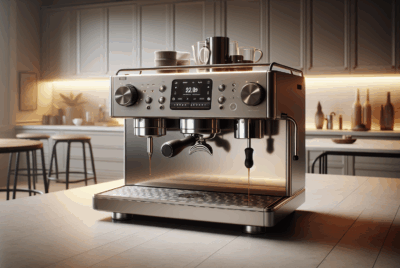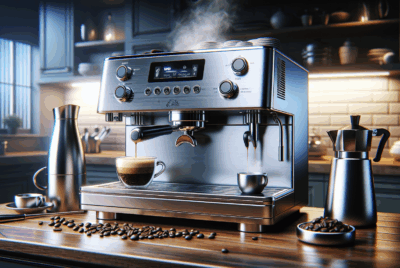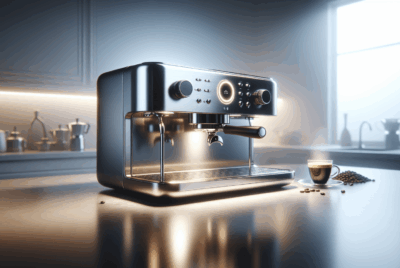Espresso Machine Troubleshooting: Common Issues and Solutions
As an Amazon Associate, I earn from qualifying purchases, at no additional cost to you. Disclaimer
My espresso machine is my morning hero. When it suddenly causes problems, it can be frustrating.
Most common issues with espresso machines often have simple solutions, like checking the water tank or cleaning the machine. Knowing how to troubleshoot effectively can save time and money.

Sometimes, the espresso tastes off or the machine isn’t producing enough steam. In these cases, cleaning the machine or descaling it regularly can make a big difference.
I make sure to keep up with regular maintenance to avoid these hiccups.
If the machine isn’t turning on, it’s likely a power issue. I always check the power cord and the outlet first. Understanding these basics of troubleshooting can help ensure that my espresso is just the way I like it, every day.
Understanding Your Espresso Machine
To get the most out of my espresso machine, I need to know its key parts and how they work together.
I focus on the machine settings first. Keeping the right brewing temperature is crucial, usually around 195-205°F. This helps extract the perfect flavors from the coffee.
Next, I look at water pressure. It should be around 9 bars. This ensures the coffee grounds are evenly saturated, producing a consistent shot. If the pressure is off, the espresso might be too bitter or weak.
Steam pressure helps me create creamy milk froth for lattes or cappuccinos. If steam isn’t strong enough, it might be a sign of a problem. I often check this part to make sure my drinks come out right.
A reliable grinder is important, too. Sometimes, I face grinder issues that affect the quality of the espresso. I tweak and adjust the grinder for best results by calibrating it to get a consistent grind size.
Calibration of the machine itself is something I never overlook. By adjusting settings regularly, I keep the machine working at its best. It’s like tuning a musical instrument.
Finally, my brewing technique plays a role. I practice pulling the lever at the right speed to achieve a smooth shot. Understanding these elements makes using the machine easier and more enjoyable.
Routine Maintenance
Taking good care of an espresso machine involves regular cleaning and managing hard water with the right filters. These steps help prevent scale buildup and keep everything running smoothly.
Regular Cleaning and Descaling
I make sure to clean my espresso machine daily. After each use, I wipe down surfaces and clean the steam wand. This stops milk residue from building up.
Every week, I do a deeper clean. I remove and scrub parts, like the portafilter and drip tray, with warm, soapy water.
Monthly, I descale the machine to remove limescale from internal pipes. For this, I use a descaling solution per the machine’s instructions. I always rinse well afterward to ensure no residue is left.
Water Filters and Hard Water Management
Managing hard water is crucial for my espresso machine’s longevity. I use a water filter to reduce minerals that cause scale buildup. Installing an inline filter or using filtered water helps.
I replace my water filter every three to six months, depending on usage and water hardness. If my water is very hard, I might replace it more often. This practice protects against scale, ensuring better-tasting coffee and prolonging the machine’s life. Monitoring water quality with test strips helps me decide how often to change the filter.
Common Espresso Machine Problems

Espresso machines, like all appliances, can run into issues. Problems such as clogs and blockages, electrical faults, inconsistent heating, and grinder malfunctions are common. Recognizing these troubles early can save time and frustration.
Clogs and Blockages
When your espresso machine is clogged, coffee can taste weak or flow slowly. This often happens when coffee grounds block the group head or portafilter.
To fix this, I use a soft brush to clean the components regularly. Backflushing with cleaner can also help remove stubborn residues. If the problem continues, checking internal tubes for blockages might be necessary.
Electrical Issues and Blown Fuses
Electrical issues can be frustrating. If the machine won’t turn on, a blown fuse might be the cause.
First, I check the power outlet to ensure it’s working. If it is, inspecting the machine’s power switch and fuse is next on my list. Replacing a faulty fuse requires caution to avoid more damage. Knowing your machine’s electrical design can be handy in these situations.
Machine Not Heating and Temperature Irregularities
An espresso machine might not heat properly, affecting the coffee’s taste. When this happens, I inspect the thermostat. A malfunctioning thermostat can make the temperature inconsistent.
I check the heating element for damage, as it might need replacement. By keeping the machine clean and descaling regularly, I reduce the chances of temperature problems.
Water and Steam Pressure Concerns
Nice espresso depends on good water and steam pressure. If the pressure is low, espresso can taste off.
Cleaning the steam wand and checking for leaks are my first steps. Watching the pump for issues is crucial as well. A pump not working correctly might need professional servicing. Proper adjustment of pressure settings ensures the machine runs smoothly.
Grinder Malfunctions and Grind Size Inconsistencies
Espresso quality relies on consistent grind size. A grinder that malfunctions can cause problems. If the grind is too fine, it might clog the machine. If too coarse, coffee will taste weak.
I regularly clean the grinder and check its burrs. Adjusting the settings for the right grind size is important. Regular maintenance helps the grinder perform well, ensuring perfect espresso every time.
Troubleshooting Techniques

I often encounter a variety of challenges when working with espresso machines. These include water leaks, steam wand issues, tamping, extraction problems, and taste concerns. Each issue requires specific techniques to resolve. Below, I share solutions for these common problems that arise during my espresso journey.
Resolving Water Flow and Leaking Issues
Water leaks or inconsistent flow can disrupt the brewing process. Check seals and gaskets for wear or damage. Replacing faulty parts can stop leaks. If the machine isn’t dispensing coffee, inspect the water reservoir for blockages or check if it’s properly seated.
Sometimes, water keeps running even after brewing. This could mean there’s an issue with the solenoid valve. Cleaning or replacing it often solves the problem. Use a regular cleaning schedule to keep the pathways clear.
Fixing Steam Wand and Milk Temperature Problems
A clogged steam wand affects milk frothing. I recommend regularly cleaning the wand with a pin or brush. Soak it in hot water if necessary. If milk isn’t reaching the right temperature, ensure that you purge the steam wand before use to expel any residual water.
Monitor the temperature of your milk with a thermometer to confirm it’s between 150°F and 160°F. This range improves both quality and taste. Make sure the steam pressure is sufficient and consistent, as low pressure can hinder proper frothing.
Adjusting Tamping Pressure and Coffee Ground Distribution
Tamping pressure is crucial for extracting espresso. Apply even and consistent pressure when tamping the coffee grounds. Uneven tamps lead to channeling, causing poor extraction. I find that around 30 pounds of pressure usually works well.
Check the distribution of coffee grounds in the portafilter. Use a distribution tool or gently tap the portafilter before tamping. This helps in achieving an even bed of coffee, reducing chances of over or under extraction.
Addressing Over-Extraction and Under-Extraction Issues
When espresso tastes bitter, it may be over-extracted. This occurs if the coffee grounds are too fine or if the brewing time is too long. To fix this, adjust the grind size larger or reduce the brewing time.
Under-extraction makes espresso taste sour. Here, the issue may be too coarse a grind or a short brewing period. Try a finer grind or extend the extraction time. Consistency in your method can prevent these problems.
Handling Espresso Taste and Crema Quality
Espresso that tastes off or has poor crema quality can result from various factors. Use fresh, quality beans and ensure they’re stored properly. Stale beans lead to poor taste and crema.
Monitor water temperature during brewing. Too hot or cold can affect flavor. Aim for a range between 195°F and 205°F. Keep your equipment clean to avoid flavor contamination. These adjustments enhance both taste and crema.
Frequently Asked Questions

I’ve noticed that espresso machines can sometimes have common issues. From brewing problems to leaks, there are a few areas to check when your machine isn’t working as expected.
Why is my espresso machine not brewing espresso correctly?
If your espresso isn’t brewing right, the grind size might be off. Finer grinds can make a big difference. Also, check the temperature and pressure settings on your machine. These factors can affect the brew quality significantly.
What could cause my espresso machine to leak from the bottom?
A leak might happen if the water reservoir isn’t seated properly. Another possibility is a damaged or clogged gasket. Make sure everything is tight and check for any visible wear or cracks in the seals.
How do I fix an espresso machine that is not pumping water?
When the machine isn’t pumping water, I often find there’s a blockage in the water line or filter. Cleaning these parts with a descaling solution can help. Ensure the pump is functioning, as it may need replacement if faulty.
What steps should I take when my espresso machine is not working?
Start by checking the power supply and ensuring everything is plugged in correctly. I also suggest examining the most used parts like the portafilter, steam wand, and water reservoir for any visible issues or wear.
How can I troubleshoot an automatic espresso machine effectively?
I usually follow the user manual for specific guidance on my machine. Running a cleaning cycle and checking internal sensors or buttons for responsiveness is helpful. Regular maintenance often prevents many issues.
What should be done when espresso flow is inconsistent or stops?
Inconsistent flow often means there’s an issue with pressure or blockages.
Cleaning the brew head and checking the pump pressure could resolve this.
Adjusting the grind size and tamping pressure may also help stabilize the flow.



